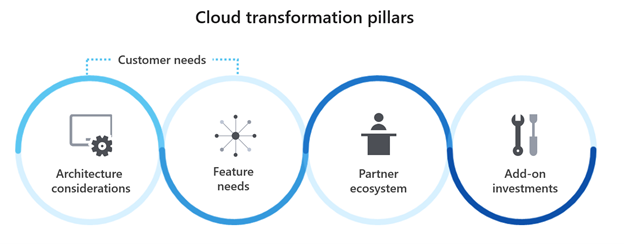 Overhauling the call management system Microsoft used to make 70 million calls per year has been a massive undertaking.
Overhauling the call management system Microsoft used to make 70 million calls per year has been a massive undertaking.
The highly complex system was 20 years old and difficult to move on from when, five years ago, the company decided a transformation was needed.
These phone calls are how Microsoft talks to its customers and its partners. We needed to get this right because our call management system is one of the company’s biggest front doors.
– Matt Hayes, principal program manager, OneVoice team
Not only did Microsoft install an entirely new call management system (which is now fully deployed), it did so on next-generation Microsoft Azure infrastructure with global standardization, new capabilities, and enhanced integration for sales and support.
“These phone calls are how Microsoft talks to its customers and its partners,” says Matt Hayes, principal program manager of the OneVoice team. “We needed to get this right because our call management system is one of the company’s biggest front doors.”
Looking back, it was a tall order for Hayes and the OneVoice team, the group in charge of the upgrade at Microsoft Digital, the engineering organization at Microsoft that builds and manages the products, processes, and services that Microsoft runs on.
What made it so tough?
The call management system was made up of 170 different interactive voice response (IVR) systems, which were supported by more than 20 separate phone systems. Those phone systems consisted of 1,600 different phone numbers that were dispersed across 160 countries and regions.
Worst of all, each of these systems was working in isolation.
[This is the second in a series on Microsoft’s call center transformation. The first story in the series documents how Microsoft moved its call centers to Microsoft Azure.]
Kickstarting a transformation
The OneVoice team kicked off Microsoft’s bid to remake its call management system with a complex year-long request for proposal (RFP) process. The team also began preparations with the internal and external stakeholders that it would partner with throughout the upgrade.
To help manage all these workstreams, projects were divvied up into categories that each had their own dedicated team and mandate:
Architecture: This team considered network design and interoperability with the cloud.
Feature needs: This group was charged with ensuring the new system would support business requirements and monitoring needs. They were also tasked with calling out enhancements that should be made to the customer experience.
Partner ecosystem: This team made sure the needs of partners and third-party players were considered and integrated.
Add-on investments: This group made sure cloud space needs were met, addressed personnel gaps, and pursued forward-looking opportunities.
These initial workstreams became the pillars used to guide the transformation of the call management system.

The key to the upgrade was the synergy between the OneVoice team and the call center teams scattered across the company, says Daniel Bauer, senior program manager on the OneVoice team.
“We decided we were going to move to the cloud—after that was approved, we knew it was time to bring in our call center partners and their business representatives,” Bauer says. “That collaboration helped us build a successful solution.”
Early input from these partners guided the architectural design. This enabled the team to bake in features like end-to-end visibility of metrics and telemetry into both first and third-party stacks. It allowed them to manage interconnected voice and data environments across 80 locations. Importantly, it also set early expectations with telecom service providers around who would own specific functions.
Designing for scale by starting small
Bringing myriad systems together under one centralized roof meant the team had to build a system that could handle exponentially greater amounts of data and functionality.
This required a powerful cloud platform that could manage the IVR technology and a call routing system that would appropriately direct millions of calls to the right agent among more than 25,000 customer service representatives.
“Just the scope of that was pretty intense,” says Jon Hoyer, a principal service engineer who led the migration for the OneVoice team.
The strategy, he says, was to take a regional line of business approach. The OneVoice team started the migration in a pilot with a small segment of Microsoft Xbox agents. After the pilot proved successful, the process was scaled out region by region, and in some cases, language by language within those regions.
“There was a lot of coordination around the migration of IVR platforms and call routing logic while keeping it seamless for the customer,” Hoyer says.
Ian McDonnell, a principal PM manager who led the partner onboarding for the OneVoice team, was also faced with the extremely large task of moving all the customer service agents to the new platform.
For many of these partners, this was a wholesale overhaul that involved training tens of thousands of agents and managers on the new cloud solution.
“We were replacing systems at our outsourcers that were integral to how they operated—integral to not only how they could bill their clients, but enabled them to even pay their salaries,” McDonnell says. “We had to negotiate to make sure they were truly bought in, that they not only saw the shared return on investment, but also recognized the new agility and capabilities this platform would bring.”
Build and deploy once, impact everywhere
When a change is made to a system, no one wants to have to make that change again and again.
When we had 20 separate disconnected systems at our outsourcers, it was an absolute nightmare to make that work everywhere. Now we can build it once and deploy that experience across the whole world.
– Ian McDonnell, principal PM manager, OneVoice team
One of the biggest operational efficiencies of the new centralized system is the ability to build new features with universal deployments. If the hold music or a holiday message needs to be changed, rather than updating it on an individual basis to every different phone system, that update goes out to all suppliers at once.
“When we had 20 separate disconnected systems at our outsourcers, it was an absolute nightmare to make that work everywhere,” McDonnell says. “Now we can build it once and deploy that experience across the whole world.”
Previously, there was no option to redirect customers from high- to low-volume call queues, leaving the customer with long waits and negatively impacting their experience. Now, with a single queue, customers are routed to the next available and most appropriate customer service agent in the shortest time, whether the agents sit in the US, India, or the Philippines, providing additional resilience to the service.
This cloud native architecture allowed for new omnichannel features such as “click-to-call,” where customers who are online can request a callback. This allows seamless continuity of context from the secured online experience to a phone conversation for deeper engagement.
As the OneVoice team explores what’s next in add-on investments, they’re exploring a wide range of technologies and capabilities to modernize the call center environment. One of the primary areas of focus is leveraging the speech analytics technology of Microsoft Azure Cognitive Services, which can provide deeper insights into customer satisfaction and sentiment.
In an upcoming blog post in this series, the OneVoice team will share how an in-house development leveraging Microsoft Azure Cognitive Services allowed the team to revolutionize customer sentiment tracking and identify issues before they become major problems.
To contact the OneVoice team, and learn more about their customer support cloud journey, email them at onevoice@microsoft.com.







